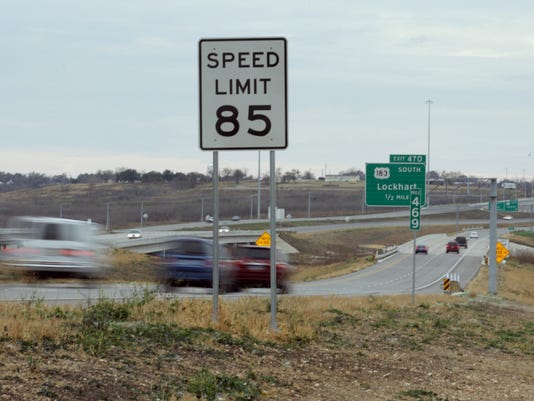
FLOOR IT?!
Over the summer I had the pleasure of taking a road trip to Houston, Texas to help move my older sister there for a co-op with Exxon Mobil. One of the stark difference about Texas is the topography. Living in Pittsburgh, there are hills everywhere, and as a result, the roads are quite curvy and the speed on most interstates is 65 mph. But, in Texas, everything is flat, and the majority of their interstates have speed limits of 75 mph or greater. This was very exciting considering that I have a lead foot. I did wonder, however, about the safety consequences of the increased speed limits, and if there was a causation between automotive accident rates and/or fatality rates and speed limits. I also wondered how speed limits are determined.

Texas Highway 130’s 85mph speed limit.
The issue of determining speed limits is a prominent issue in the United States especially with recent advancement in automotive technology. Adrian Lund, the president of the Insurance Institute of Highway Safety (IIHS), stated,”The cars now make you feel more comfortable when you are going 85, 95 or even 100 miles per hour. Ten years ago, when a car got up around 80 or 85 miles per hour, it did not handle as well and you didn’t feel as comfortable driving it.” There is a growing trend in states to raise speed limits, the current highest posted speed limit being Texas State Highway 130 at 85 mph, and many safety groups such as the IIHS are starkly opposed. They propose that the recent trends “in [the] 24 states that raised speed limits… [resulted in] 15 percent more fatalities on interstates and freeways than otherwise would have been expected.” The institute continues in their status report by stating, “Even with today’s speed limits, speed-related crashes cause more than 10,000 deaths a year — nearly a third of all crash fatalities in the country. States could prevent some of these deaths if, instead of giving drivers permission to go ever faster, they vigorously enforced existing limits to slow drivers down.”
However, many statistics they use are somewhat misleading. For example, speed-related crashes is a very broad category, and by investigating further, the National Highway Traffic Administration defines speed-relating accidents as “any crash in which the police indicate that one or more drivers involved was exceeding the posted speed limit, driving too fast for conditions, driving at a speed greater than reasonable or prudent, exceeding a special speed limit or zone, or racing.” Also, the federal agency states that “there is a significant overlap between alcohol involvement and speed…this same caveat applies to many of the other scenarios examined in this report, as multiple factors can be involved in any given crash.” From reading the actual report that the IIHS refers to, their statistical argument is diminished because there are many confounding variables which are conveniently ignored.
The IIHS and proponents of lower speed limits will often point to 1974, the year the a national speed limit was set to 55mph. Although this was to combat the energy crisis, safety proponents exalted the fact that “the first year after the lower limits were in place, highway deaths plunged by 15 percent.” This fact was revealed as a fallacy when the CATO Institute unearthed that fatalities most likely declined as a result of the energy crisis itself. After all, “higher gas prices reduced driving by about 20 to 30 percent in many states.” The fatality rate likely fell because less people were driving.
Furthermore, a CATO Institute analysis of states’ speed limits provide evidence against the hypothesis that increasing speed limits increases accidents and fatalities. In 1995, the national government repealed national speed limit laws, returning sovereignty to the states. The analysis stated, “Although 33 states raised their speed limits between the 1995 repeal of the mandatory federal speed limit and August 1996, the National Highway Traffic Safety Administration reported last October that “the traffic death rate dropped to a record low level in 1997 (1.6 deaths per 100 million vehicle miles traveled).”
Determining a safe speed limit is largely based on statistics. The Michigan State Police Traffic Services Section determined that the safest speed is what 85% of people drive at or below. The report states that this speed, “provides the lowest speed variance between vehicles, and thus provides the lowest crash numbers.” Michigan State police argue that speed variance is the main problem not velocity. A common argument against this notion is that people will always exceed the limit posted. The IIHS states, “People often drive faster than the speed limit, and if the limit is raised they will go faster still.” But, Michigan State police disagree. In their report, they state how “travel speeds don’t change” when the posted speed limit increases or decreases. What changes is the public perception, and their perception does not align with reality which is why it is important to set speed limits that limit speed variation.
